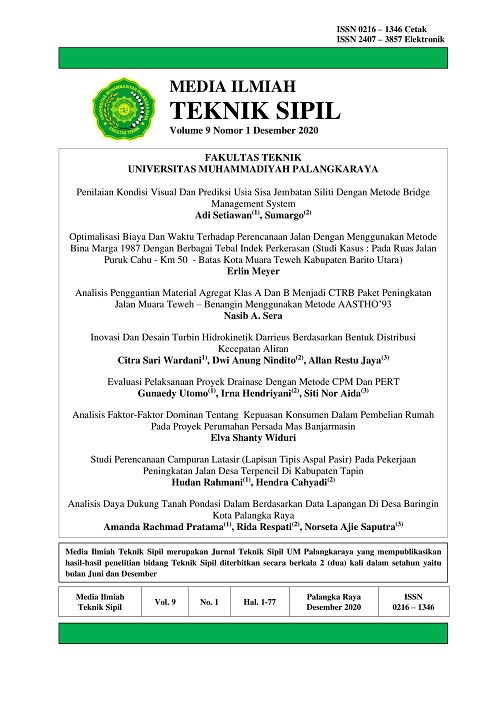Optimalisasi Biaya Dan Waktu Terhadap Perencanaan Jalan Dengan Menggunakan Metode Bina Marga 1987 Dengan Berbagai Tebal Indek Perkerasan (Studi Kasus : Pada Ruas Jalan Puruk Cahu - Km 50 - Batas Kota Muara Teweh Kabupaten Barito Utara) Costs And Time Optimization Of Road Planning Using The Bina Marga 1987 Method With Various Thickness Of Pavement Index (Case Study: On Puruk Cahu - Km 50 - Muara Teweh City Boundary, North Barito Regency)
Main Article Content
Abstract
Pavement planning is good, because in this way the pavement construction is able to carry the load of vehicles passing on it and spread the load to the layers beneath it, including the subgrade, without causing significant damage to the road construction itself. The purpose of this study is to obtain the most efficient alternative pavement thickness index and to obtain the required cost and time. The results showed that the Pavement Thickness Index (ITP) using the Bina Marga Method = 7.48 and the 1993 AASHTO Method = 10.20 had a difference of 2.72. The difference in Pavement Thickness Index (ITP) resulted in the addition of pavement thickness using the 1993 AASHTO Method. The economical Pavement Thickness Index (ITP) was the ITP Bina Marga Method with a construction cost of Rp 12.7 billion, with savings of Rp 3.8 billion. By determining the pavement thickness at the same base layer = 20 cm, it is found that the type of material is Aggregate Class B, CBR is 80% cheaper than cement + CTRB with savings of Rp 913,991,544, - ~ 1 billion. The time required in implementing the Bina Marga Method is more efficient than the 1993 AASHTO Method with a savings of 44 days, this is due to cement work + CTRB = 15 + 29 = 44 days. While Aggregate Class B, CBR 80% only takes 22 days, thus saving 22 is also due to the larger ITP of the 1993 AASHTO Method so that it requires additional thickness of the base layer under Aggregate Class C, CBR 30% of 22 cm thus increasing the duration of the implementation time by 24 days
Downloads
Article Details
All rights reserved. This publication may be reproduced, stored in a retrieval system, or transmitted in any form or by any means, electronic, mechanical, photocopying, recording.
References
Departemen Pekerjaan Umum Direktorat Bina Marga, (2002). Buku Petunjuk Teknis analisa Biaya Harga Satuan Pekerjaan Jalan Kabupaten.
Departemen Pekerjaan Umum Direktorat Bina Marga, (2005). Sifat-sifat Aggregat.
Departemen Pekerjaan Umum Direktorat Jendral Bina Marga, (1987). Petunjuk Perencanaan Tebal Perkerasan Lentur Jalan Raya Dengan Metode Analisa Komponen SKBI 2.3.26.1987. Departemen Pekerjaan Umum, Jakarta.
Depkimpraswil, (2003). Campuran Beraspal Panas, Modul Prasarana Transportasi, Modul B.1.1 dan 2. Badan Penelitian dan Pengembangan Departemen Pemukiman dan Prasarana Wilayah.
Dethan, Paul Oktavianus, (2012). Perencanaan Dan Teknis Pelaksanaan Jalan Dengan Metode Analisa Komponen Pada Kawasan Alak Kabupaten Kupang. Teknik Sipil ITS, Surabaya.
Direktorat Jendral Bina Marga, (1992). Pedoman Pelaksanaan Pemeliharaan Jalan dan Jembatan. Jakarta.
Domone, Peter., Illston, John., (2010). Wirtgen’s Cold Recycling Manual
Peraturan Pemerintah Nomor 34 Tahun 2006 tentang jalan.
Peurivoy and Oberlender, (1989). The Size Of The Site, Extent Of Water Present, Soil Types, Topografy And Weather Determine The Kind Of Aquipment Usedin Site Clearing And Grading.
Puslitbang Kementerian Pekerjaan Umum, (2002). Lapis Tambahan Diatas Daur Ulang. Jakarta.
Smith, (1995). Perhitungan Rencana Anggaran Biaya Perkerasan Beton Semen Menerus
Soeharto, Iman., (1995). Manajemen Proyek dan Konseptual sampai Operasional. Erlangga, Jakarta.
Sukirman, S., (2003). Perkerasan Lentur Jalan Raya, Nova, Bandung.
Sunarto, (2009). Perencanaan Jalan Raya Cemorosewu-Desa Pacalan dan Rencana Anggaran Biaya. Jurusan Teknik Sipil Universitas Sebelas Maret Surakarta, Surakarta.
Undang-undang Nomor 38 Tahun 2004 tentang jalan
Yudhatama, Hendy, (2011). Perencanaan Peningkatan Jalan Bangkalan – Bts. Kab Sampang STA 23+000 – 26+000, Madura. Teknik Sipil, ITS. Surabaya.
